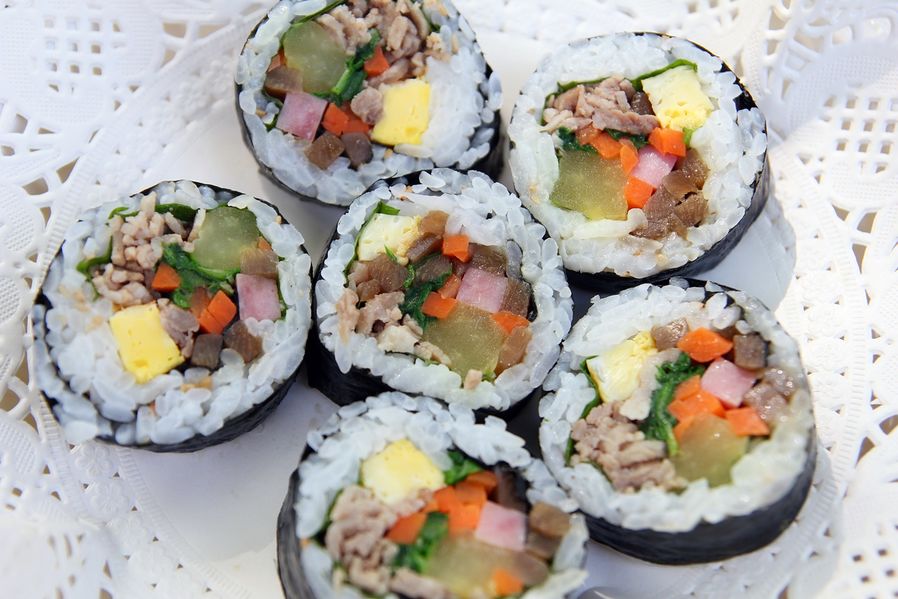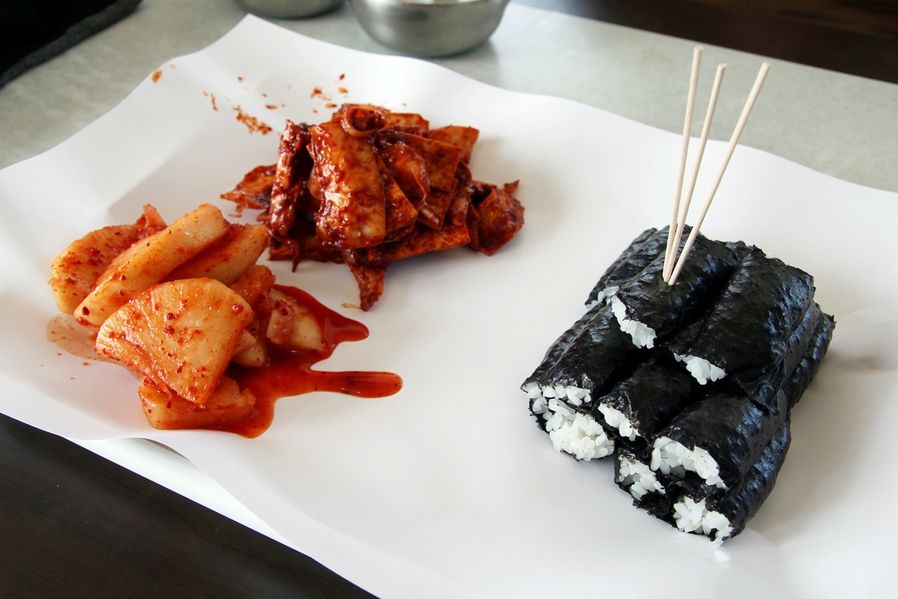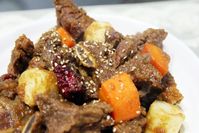1. Ingredients for Gimbap
- Primary ingredients: Gim and steamed white rice (mixed with sesame oil and salt)
- Secondary ingredients: Carrot, spinach, egg, pickled radish, fried fish cake and ham
2. Taste evaluation
-Spicy: :☆☆☆☆☆
-Salty: ★★☆☆☆
-Sweet: ★☆☆☆☆
-Sour: ★☆☆☆☆
-Toasted flavor:★☆☆☆☆
3. Introduction to Gimbap
Gimbap is convenient to eat made from steamed rice (bap) and various ingredients. It’s easy to carry so Koreans used to bring it to a picnic or trip since a long time ago.
Some say that Gimbap is Korean traditional food while some say it’s Japanese food.
At least in Korea, there used to be a food called Bokssam, rice and a few ingredients wrapped in Gim(sheets of dried laver seaweed) in Goryo Dynasty era.
There’s not much information on Bokssam so we have no clue if it’s same as today’s Gimbap but it was for sure made from rice and Gim.
Secondly, some say that it’s Japanese food. Japan also had Nori-maki that is made from steamed rice and Gim since long ago.
Nori-maki is characterized by use of vinegar in rice and it has many variations depending on ingredients and shapes. And it’s been said that one of those variations was passed to Korea.
Taken together, Gimbap has a long history in Korea but the specific recipe has not been known so it could be possible that the recipe has been influenced by Japanese one.

Gimbap is made by putting steamed white rice sauced with sesame oil and salt, sliced carrots, spinach, eggs, pickled radish, fried fish cake and ham on a big square Gim, rolling it and cutting it into bite-size slices.
The difference would be that Japanese use sour vinegar (Japanese) while Koreans use toasted-flavored sesame oil and salt(Korean).
But sometimes Koreans also use vinegar so it tastes similar to Japanese one.
One roll of Gimbap has various ingredients including rice, vegetables and ham, which is enough for one meal.
It’s loved by everyone since unique tastes of Gim, well-cooked rice, crunchy vegetables, soft egg, salty fried fish cake and ham are harmonized with each other.
There’s no need to prepare other dishes and one roll is enough for a meal so people look for this for a convenient meal.
It’s delicious and easy to eat that makes it perfect for picnic or trips.
Plus, it is one of cuisines that make Korean people happy for it reminds them of pleasant picnic or trip.
It’s very accessible because the number of Gimbap chain shops is the biggest in Korea.
Even if you can’t find any, you could get it from the convenience store as well.
BUT! You might be disappointed by the taste sold in the convenience store so if you like to try proper Gimbap, don’t give up on finding Gimbap shops.
I hope you could try it at least once because you don’t even have to worry about the price.
4. Kinds of Gimbap
There could be so many kinds of Gimbap because you can put any ingredient you want along with rice in Gim.
Most popular ones in Korea would be as follows.
Yachae(vegetables)-gimbap: Basic Gimbap with carrots, spinach, eggs, pickled radish, and fried fish cake along with rice rolled in Gim
Ham(ham)-gimbap: Extra ingredient, ham, is added to Yachae Gimbap
Chamch(tuna)-gimbap: Extra ingredients, canned tuna with mayonnaise sauce and perilla leaves, are added to Yaechae Gimbap
Sogogi(beef)-gimbap: Extra ingredient, fried beef, is added to Yachae Gimbap
And there are Chungmu-gimbap and Ggongchi-gimbap that you can only see in particular regions.
Chungmu-gimbap: It’s only available in Tongyeong province, Gyeongsangbuk-do, which is steamed whit rice rolled in Gim without any salt, and served with spicy fish cake or squid.
Ggonchi(saury)-Gimbap: It’s only available in Jeju-do that is made from steamed white rice and one grilled saury rolled in Gim.
I say you should try not too strong one for foreigners like Yachae(vegetables)-, Chamchi(tuna)- and Sogogi(beef)-gimbap.

Canon EOS 550D | f/6.3 | iso 100 | 2013:02:08 13:48:15 | Flash did not fire, compulsory flash mode | 19mm
5. How to enjoy Gimbap even more
You shouldn’t miss trying Korean food once you’re in Korea.
Get out of small restaurants and enjoy Korean food outdoors.
There’s gotta be at least one Gimbap shop near your hotel or bus/subway stations.
Buy Gimbap to-go and eat it outside. As if you’re on a picnic.
Even so, you cannot eat it when it’s prohibited including famous tourist sites such as Gyeongbokgung or museums.
But you’re allowed to eat near your hotel or parts near tourist sites.
For example, the bench under the tree of Myeongdong Church or Hangang River lawn is a good place for a picnic.
As long as there’s green grass and trees, you could sit on any bench and enjoy your picnic day.
Gimbap is very popular outdoor food in Korea so nobody would say anything to you.
Although you cannot interrupt people walking by or leave the trash or leftovers.
I’ve also had sandwiches and drinks at Central Park in New York, Ueno Park in Japan, Botanic Gardens in Singapore, and Chao Phraya Riverside in Thailand.
It is quite a memory because I could just get away from all the pressures from busy travel schedule and enjoy relaxing time while eating sandwiches.
Relaxing picnic in the midst of busy travel schedule! I want you to have it.











